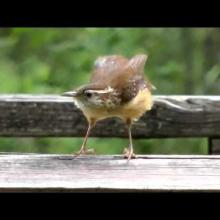

Join BirdNote tomorrow, November 30th!
Illustrator David Sibley and actor H. Jon Benjamin will face off in the bird illustration battle of the century during BirdNote's Year-end Celebration and Auction!
To locate where a sound is coming from, we use time lag. A sound coming from the left is first detected by the left ear, then ever-so-slightly later by the right ear. But the ears of some small birds (like these Carolina Wrens) and insects are too close together for them to use time lag alone. So they augment it by detecting a difference in pressure on their eardrums. Different ways of hearing, but no less effective.
BirdNote®
Locating a Bird by Sound
Written by Bob Sundstrom
This is BirdNote.
[Carolina wren, https://macaulaylibrary.org/asset/94253,0.03-.08]
When we hear a bird sing, how do we know which direction to look, in order to see it?
[Carolina wren, https://macaulaylibrary.org/asset/94253,0.03-.08]
Our brain uses a time lag to mark the location of a sound. A sound coming from the left — like this Carolina Wren song — is first detected by the left ear, then ever-so-slightly later by the right ear, which tells us the singer sits to our left.
[Carolina wren, https://macaulaylibrary.org/asset/239386881]
The time lag in the sound reaching one ear (tiny tiny pause) and then the other is our main clue to location. Many animals locate sounds this way. But the ears of some small birds and insects are too close together for them to use time lag alone. So they augment it by detecting a difference in pressure on their eardrums.
[Carolina Wren, https://macaulaylibrary.org/catalog?taxonCode=carwre&mediaType=a&sort=r…, 0.4-0.7]
In those small creatures, the ears are connected by an air tunnel through the animal’s body. As sound travels between the ears, the eardrums are activated by different sounds at their outer and inner surfaces. The difference between the vibrations of the two helps the animal determine the source of the sound.
[Carolina wren, https://macaulaylibrary.org/asset/94253,0.03-.08]
Both you and that female Carolina Wren can hear where the male is —but how the two of you locate him is based on a different process.
[Carolina wren, https://macaulaylibrary.org/asset/94253,0.03-.08]
For BirdNote, I’m Michael Stein.
###
Senior Producer: John Kessler
Production Manager: Allison Wilson
Producer: Mark Bramhill
Associate Producer: Ellen Blackstone
Bird sounds provided by The Macaulay Library of Natural Sounds at the Cornell Lab of Ornithology, Ithaca, New York. Carolina Wren ML94253 and ML239386881 recorded by W. Hershberger
BirdNote’s theme was composed and played by Nancy Rumbel and John Kessler.
© 2021 BirdNote May 2021 Narrator: Michael Stein
ID# hearing-02-2021-05-31 hearing-02
Reference: https://www.google.com/amp/s/phys.org/news/2008-01-localize.amp



